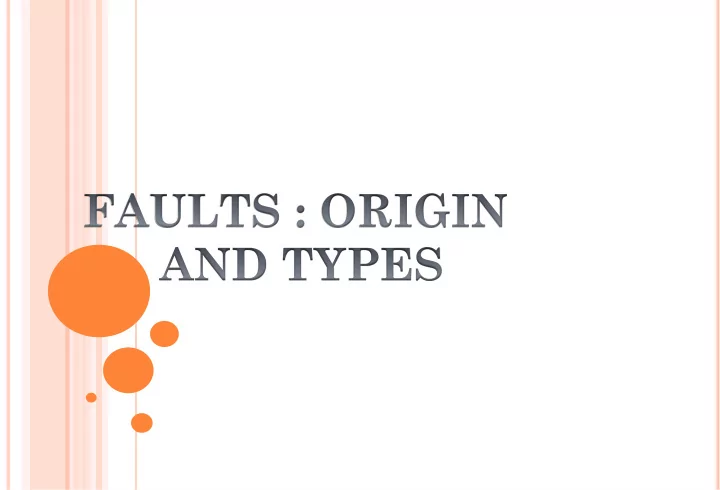

DEFINITION: Fault represents a linear break in the rocks of the earth surface along which there has been displacement in horizontal, vertical and oblique direction due to tensional process. In other words, when the crustal rocks are displaced due to tensional movement caused by endogenetic forces along the plain the resultant structure is called a fault. According to Oxford Dictionary of Geography fault is “ A fractured surface in the earth ’ s crust along which rocks have travelled relatively to each other ” . For example- The Tecton Fault in Woming province of USA which is nearly 50km long. FIG G 1: FAUL ULT
DIFFERENT PARTS OR COMPONENTS OF A FAULT Fault plain: It refers to the plain along • which the rock beds are displaced. Fault dip: It is the angle between the • fault plane and the horizontal plane. Upthrown slide: It represents the upper • most block of a fault. Downthrown side: It represents the • lower most block of a fault. Hanging wall: It represents the upper • wall of a fault. Foot wall: It represents the lower wall • of a fault. Fault Scarp: It represent the steep wall • like slope caused by faulting. Fig 2: Different parts of Faults
DIFFERENT PARTS OR COMPONENTS OF A FAULT Dip slip movement: when faulting • occurs along the dip. Strike slip movement: when faulting • occurs along the strike. Sliken side: when fault plane becomes • smooth, it is called sliken side. Fault Breccia: when fault plane • becomes angular, it is called fault breccias. Heave: the lateral displacement in • between several tilted fault is called fault. Strike: it refers to the line on which • fault plane and horizontal plane cuts one another. Fault line: it refers to the line along • which fault plane and earth ’ s crust cuts one another. Fig 3: Different parts of Faults
CLASSIFICATION OF FAULTS: • According to geometric pattern: according to geometric pattern faults can be classified on the basis of 5 sub-categories- (i)On the basis of the presence of hanging wall and foot wall: 1. Normal Fault : Normal faults are formed due to the displacement of both the rock block in opposite direction. The fault plane is usually 45 ° or nearly vertical. 2. Reverse Fault: Reverse Faults are formed due to the movement of both the fracture rock block towards each other. The fault plane, in a reverse fault, is uaually inclined in an angle between 40 ° (0 ° ). and horizontal It is also obvious that some sort of compression is also involved in the formation of reverse fault. These are also called Thrust Fault or Compressional Fault. Fig 4: Normal Fault and Reverse Fault
ii) On the basis of net slip: 1. Dip Slip Fault: It refers to the fault in which the net slip is found as per the angle of the fault. In this type of fault net slip and dip slip remains equal. 2. Strike slip fault: it refers to the fault in which the net slip occurs along the strike of the fault in this type of fault the net slip and strike slip becomes equal. 3. Oblique slip fault: when the angle between the net slip and the strike of the fault remains in between 10 ° -80 ° . It is Fig 5: Dip slip, Strike slip, oblique slip fault called oblique Slip fault.
iii) On the basis of the angle between the strike of the fault plane and the strike of the rock beds: 1. Net slip fault: It refers to the horizontal distance between two faulted crustal blocks. These may be measured by A) distance, B) angle. 2. Dip Slip Fault: discussed earlier. 3. Strike slip fault: discussed earlier. FIG 6. Net slip, Dip Slip & Strike slip Fault iv) On the basis of the angle between fault plane and strike plane:
v) On the basis of pattern of the fault: 1.Parallel fault: It refers to a bunch of fault having same dip and strike . 2. Radial fault: A number of fault showing radiating pattern are called radial faults. This are also called Arcuate (curved) or Peripheral faults. 3.En e’ chelon: It refers to the faults which are horizontally parallel but remains face to face to each other in the marginal part. Fig 7: parallel fault Fig 8: Radial fault and En e’ chelon fault 4. Peripheral fault: These are circular faults occurring in a bunch.
5. Step fault: When fault occurs in a step like series it is called step faults. This type of fault is common in Bhog Mountain in western France. Fig 9: Step Fault 6. Ridge Fault: These are the faults along which rift valleys are formed. Fig 10. Ridge Fault 7. Kaibal fault: These are the faults with the uniclinal curve on one side and trench on other side.
vi) On the basis of the origin of fault: 1.Transform fault or sub surface fault: In 1967 a newly variety of strike slip faults was identified by Tuzo Wilson which he called Transform Faults. This was first found in the mid-oceanic ridges as the new oceanic crust moved away from them. The transform faults occures in between two divergent plates. One example of transform faults is in the boundary of North America and pacific plate. Fig 11: Transform Fault Fig 12: Tear Fault 2. Strike-slip or tear faults: It is a vertical fracture but instead of vertical movement the movement of the slide related to the other displacement is horizontal along the line of the fault . It is also called Transcurrent Fault, Lateral Fault. Examples- San Andreas Fault, California; Anatolian Fault, Turkey.
IMAGE LINKS 1. https://earthquake.usgs.gov/learn/glossary/images/fault_plane.jpg 2. http://www.earthonlinemedia.com/ebooks/tpe_3e/tectonics_landforms/normal_fault_labelled_diagram.j pg 3. https://c8.alamy.com/compde/bb4fgj/arten-von-abschiebungen-in-tektonischen-erdbeben-bb4fgj.jpg 4. https://www.nps.gov/npgallery/GetAsset/1176B050-1DD8-B71B-0B34EAE14A0D61E5/proxy/hires 5. http://eqseis.geosc.psu.edu/~cammon/HTML/Classes/IntroQuakes/Notes/Images_specific/fault_types.gif 6. https://slideplayer.com/slide/3449403/12/images/11/Note+that+the+rake+angle+is+measured+from+th e+horizontal+to+the+direction+of+net-slip+on+the+fault+plane.jpg 7. http://www.geographynotes.com/wp-content/uploads/2017/02/clip_image016.jpg 8. https://image.slidesharecdn.com/faults-180613153401/95/faults-17-638.jpg?cb=1528904108 9. https://www.google.co.in/url?sa=i&source=images&cd=&cad=rja&uact=8&ved=2ahUKEwjy4b6QyvzeA hVPVH0KHeFqBRgQjRx6BAgBEAU&url=http%3A%2F%2Fwww.yourarticlelibrary.com%2Fgeology% 2Ffaults-meaning-classification-and-importance-geology%2F91572&psig=AOvVaw2K2sjRYiDA29 10.http://4.bp.blogspot.com/- Cms59fd7PiY/VmRPJhFwBeI/AAAAAAAAHOY/QKJLwOybtIM/s1600/continental%2Btransform%2Bf aults.jpg 11. https://i.ytimg.com/vi/8JBlR6AMjHE/maxresdefault.jpg 12. https://i2.wp.com/www.revision.co.zw/wp-content/uploads/2015/06/tear_fault- min.jpg?zoom=2.625&resize=392%2C224&ssl=1
THANK YOU
Recommend
More recommend